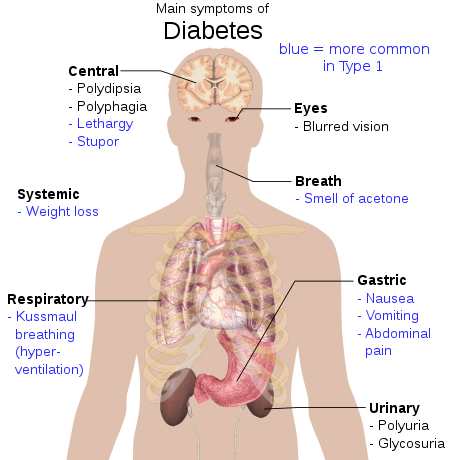Diabetes/ja: Difference between revisions
Created page with "2型糖尿病の重症例では、グルコースの目標値に達するまでインスリンを徐々に増量する治療も行われる。" |
No edit summary Tags: Mobile edit Mobile web edit |
||
| (33 intermediate revisions by the same user not shown) | |||
| Line 252: | Line 252: | ||
2型糖尿病の重症例では、グルコースの目標値に達するまでインスリンを徐々に増量する治療も行われる。 | 2型糖尿病の重症例では、グルコースの目標値に達するまでインスリンを徐々に増量する治療も行われる。 | ||
====血圧降下==== | |||
=== | [[Cardiovascular disease/ja|心血管疾患]]は糖尿病に伴う重篤な合併症であり、多くの国際的なガイドラインは、糖尿病患者に対して140/90 mmHgより低い血圧治療目標を推奨している。しかし、より低い目標値をどうすべきかについては、限られたエビデンスしかない。2016年のシステマティックレビューでは、140mmHgより低い目標値で治療することに潜在的な害があることがわかり、続く2019年のシステマティックレビューでは、有害事象のリスクは増加するものの、130~140mmHgまで血圧を下げることによる追加的な利益を示すエビデンスはないことがわかった。 | ||
[[Cardiovascular disease]] | |||
2015年の米国糖尿病学会の推奨では、糖尿病でアルブミン尿がある人は、末期腎疾患への進行、心血管イベント、死亡のリスクを減らすために、レニン-アンジオテンシン系の阻害薬を投与すべきであるとしている。[[angiotensin converting enzyme inhibitors/ja|アンジオテンシン変換酵素阻害薬]](ACEI)は、心血管疾患の予防において、[[angiotensin receptor blockers/ja|アンジオテンシン受容体拮抗薬]](ARB)や[[aliskiren/ja|アリスキレン]]などの他のレニン-アンジオテンシン系阻害薬よりも優れているというエビデンスがいくつかある。より最近のレビューでは、主要な心血管系および腎臓の転帰に対するACEIとARBの効果は同程度であった。ACEIとARBを併用することでさらなる効果が得られるというエビデンスはない。 | |||
==== アスピリン ==== | |||
= | 糖尿病における心血管疾患予防のための[[aspirin/ja|アスピリン]]の使用については議論がある。アスピリンは心血管疾患のリスクが高い人に推奨されることもあるが、アスピリンの日常的な使用は合併症のない糖尿病の転帰を改善することは認められていない。2015年米国糖尿病学会によるアスピリン使用に関する推奨(専門家のコンセンサスまたは臨床経験に基づく)は、心血管疾患リスクが中等度(10年心血管疾患リスク5〜10%)の成人糖尿病患者においては低用量アスピリン使用が妥当であるとしている。[[:en:National Institute for Health and Care Excellence|国立医療技術評価機構]](NICE)によるイングランドとウェールズの全国ガイドラインでは、心血管疾患が確認されていない1型または2型糖尿病患者にはアスピリンを使用しないよう推奨している。 | ||
===手術=== | |||
[[obesity/ja|肥満]]と2型糖尿病の患者に対する[[Bariatric surgery/ja|減量手術]]は、しばしば有効な手段である。多くの場合、術後はほとんど薬物を使用せずに正常な血糖値を維持することができ、長期的な死亡率は低下する。しかし、手術による短期的な死亡リスクは1%未満である。手術が適切である場合の[[body mass index/ja|肥満度指数]]のカットオフ値はまだ明らかではない。体重と血糖の両方をコントロールできない人にこの選択肢を考慮することが推奨される。 | |||
[[ | |||
[[pancreas transplant/ja|膵臓移植]]は、[[kidney transplantation/ja|腎臓移植]]を必要とする[[Chronic kidney disease/ja|末期腎臓病]]を含む重度の合併症を有する1型糖尿病患者に対して時折考慮される。 | |||
===自己管理とサポート=== | |||
イギリスのように[[general practitioner/ja|一般開業医]]制度を採用している国では、ケアは主に病院外で行われ、病院での専門医によるケアは合併症や血糖コントロールが困難な場合、または研究プロジェクトの場合にのみ行われる。その他の状況では、一般開業医と専門医がチームアプローチでケアを分担している。社会的処方が2型糖尿病患者の血糖コントロールのわずかな改善につながったというエビデンスが示されている。在宅[[telehealth/ja|遠隔医療]]支援は効果的な管理手法となりうる。 | |||
成人の2型糖尿病患者に対する教育プログラムを提供するための[[:en:technology|技術]]の使用には、自己管理を促進するためにテーラーメードの反応を収集するためのコンピュータベースの自己管理介入が含まれる。[[cholesterol/ja|コレステロール]]、[[blood pressure/ja|血圧]]、[[Behavior change (public health)/ja|行動変容]]([[physical activity/ja|身体活動]]レベルや食事など)、[[Depression (mood)/ja|抑うつ]]、体重、および[[Quality of life (healthcare)/ja|健康関連QOL]]に対する効果を支持する十分な証拠はなく、他の生物学的、認知的、または情動的転帰においても同様である。 | |||
==疫学== | |||
{{Anchor|Epidemiology}} | |||
{{Main|Epidemiology of diabetes}} | {{Main/ja|Epidemiology of diabetes/ja}} | ||
[[File:Prevalence of Diabetes by Percent of Country Population (2014) Gradient Map.png|thumb|upright=1.4| | [[File:Prevalence of Diabetes by Percent of Country Population (2014) Gradient Map.png|thumb|upright=1.4|2014年の世界の糖尿病の割合。世界の有病率は9.2%であった。]] | ||
[[File:Diabetes mellitus world map-Deaths per million persons-WHO2012.svg|thumb|upright=1.4| | [[File:Diabetes mellitus world map-Deaths per million persons-WHO2012.svg|thumb|upright=1.4|2012年、人口100万人当たりの世界の糖尿病死亡率{{Div col|small=yes|colwidth=10em}}{{legend|#ffff20|28–91}}{{legend|#ffe820|92–114}}{{legend|#ffd820|115–141}}{{legend|#ffc020|142–163}}{{legend|#ffa020|164–184}}{{legend|#ff9a20|185–209}}{{legend|#f08015|210–247}}{{legend|#e06815|248–309}}{{legend|#d85010|310–404}}{{legend|#d02010|405–1879}}{{div col end}}]] | ||
2017年には、世界で4億2,500万人が糖尿病を患っており、2013年の推定3億8,200万人、1980年の1億800万人から増加している。世界人口の年齢構成の変化を考慮すると、成人の糖尿病有病率は8.8%で、1980年の4.7%からほぼ倍増している。2型が約90%を占めている。糖尿病罹患率は女性と男性でほぼ等しいというデータもあるが、2型罹患率の高い多くの集団で男性過剰が認められている。これは、おそらくインスリン感受性における性差、肥満や局所的な体脂肪沈着の結果、高血圧、喫煙、アルコール摂取などの他の要因によるものであろう。 | |||
WHOの推計によると、2012年の糖尿病による死亡者数は150万人で、死因の第8位であった。しかし、それ以外の220万人の死亡は、高血糖と心血管疾患およびその他の合併症(腎不全など)のリスクの増加に起因するものであり、これらの合併症はしばしば早死にを招き、死亡診断書には糖尿病よりもむしろ根本的な原因として記載されることが多い。例えば、2017年、[[International Diabetes Federation/ja|国際糖尿病連合]](IDF)は、糖尿病が直接的または間接的に糖尿病に起因すると考えられる総死亡者数を推定するためにモデリングを用いて、糖尿病が全世界で40 万人の死亡をもたらしたと推定した。 | |||
糖尿病は世界中で発症しているが、先進国ではより一般的(特に2型)である。しかし、最も有病率が増加しているのは低・中所得国で、糖尿病による死亡の80%以上がここで起こっている。2030年には、糖尿病患者のほとんどが住むと思われるアジアとアフリカで、最も早い有病率の増加が予想されている。発展途上国における糖尿病罹患率の増加は、都市化やライフスタイルの変化(座りがちなライフスタイルの増加、身体的負担の少ない仕事、世界的な栄養転換など)に伴うもので、エネルギー密度は高いが栄養価の低い食品(砂糖や飽和脂肪酸が多く、「欧米型」食事と呼ばれることもある)の摂取が増えている。世界の糖尿病患者数は、2017年から2045年の間に48%増加する可能性がある。 | |||
2020年現在、米国成人の38%が糖尿病予備軍である。 | |||
==歴史== | |||
{{Anchor|History}} | |||
{{Main|History of diabetes}} | {{Main/ja|History of diabetes/ja}} | ||
糖尿病は最初に記述された病気のひとつであり、[[:ja:紀元前|BCE]]1500年の[[:ja:古代エジプト|エジプト]]の写本には「尿があまりにも大量に空になる」と記されている。[[:en:Ebers papyrus|エベルス・パピルス]]には、そのような場合に飲むべき飲み物の勧めが記載されている。最初に報告された症例は1型糖尿病であったと考えられている。同じころのインドの医師たちは、この病気を''madhumeha''(蜂蜜尿)と分類し、尿がアリを引き寄せることを指摘した。 | |||
「糖尿病」または「通り過ぎる」という用語は、ギリシア人の[[:en:Apollonius (physician)|メンフィスのアポロニウス]]によって前230 に初めて使用された。この病気は[[:ja:ローマ帝国|ローマ帝国]]の時代にはまれな病気と考えられており、[[:en:Galen|ガレン]]は彼のキャリアの中で2例しか見たことがないとコメントしている。これはおそらく古代人の食生活やライフスタイルによるものか、臨床症状が病気の進行期に観察されたためであろう。ガレンはこの病気を「尿の下痢」(diarrhea urinosa)と名付けた。 | |||
糖尿病について詳細に言及した現存する最古の著作は、[[:en:Aretaeus of Cappadocia|カッパドキアのアレタイオス]]のものである(紀元2世紀から3世紀初頭)。彼はこの病気の症状と経過を記述しており、その原因は湿気と寒さにあるとし、「[[:en:Pneumatic school|空気圧学校]]」の信念を反映していた。彼は糖尿病と他の病気との相関関係を仮定し、同じく過度の渇きを引き起こす蛇咬傷との鑑別診断について論じた。彼の著作は、最初のラテン語版がヴェネツィアで出版される1552年まで西洋では知られていなかった。 | |||
糖尿病の2つのタイプは、紀元400~500年にインドの医師[[:en:Sushruta|スシュルタ]]と[[:en:Charaka|チャラカ]]によって初めて別々の疾患として同定され、1つのタイプは若さと、もう1つのタイプは太りすぎと関連していた。効果的な治療は、カナダ人の[[:en:Frederick Banting|フレデリック・バンティング]]と[[:en:Charles Best (medical scientist)|チャールズ・ベスト]]が1921年と1922年にインスリンを分離・精製した20世紀初頭まで開発されなかった。その後、1940年代に長時間作用型インスリン[[NPH insulin/ja|NPH]]が開発された。 | |||
===語源=== | |||
=== | 糖尿病(''diabetes'')({{IPAc-en|ˌ|d|aɪ|.|ə|ˈ|b|iː|z}}または{{IPAc-en|d|ˌ|aɪ|.|ə|ˈ|b|iː|t|ᵻ|s}})は[[:ja:ラテン語|ラテン語]]の''diabētēs''に由来する。これは[[古代ギリシア語]]に由来する。[[wikt:διαβήτης|διαβήτης]](''diabētēs'')に由来し、文字通り「通り抜ける者、[[:en:siphon|サイフォン]]」を意味する。[[:ja:古代ギリシャ|古代ギリシャ]]の[[physician/ja|医師]] [[:en:Aretaeus of Cappadocia|カッパドキアのアレタイオス]]([[:en:Floruit|fl.]]1{{nbsp}}世紀[[:en:Common Era|CE]])は、「尿の過剰な排出」という意味のこの語を病名として用いた。最終的には、「通過する」を意味するギリシャ語のδιαβαίνειν (''diabainein'') に由来し、「通過する」を意味するδια- (''dia'') と「行く」を意味するβαίνειν (''bainein'') からなる。「糖尿病」という言葉は、1425年頃に書かれた医学書に「diabete」という形で初めて英語で記録されている。 | ||
''[[wikt:mellitus|mellitus]]''({{IPAc-en|m|ə|ˈ|l|aɪ|t|ə|s}} または{{IPAc-en|ˈ|m|ɛ|l|ᵻ|t|ə|s}})という言葉は、古典ラテン語の''mellītus''に由来する。 ラテン語の語源は''mellītus''である。) ラテン語の語源は''mell''で、''mell''は「蜂蜜」、「甘さ」、「心地よいもの」を意味する''mel''に由来し、接尾辞-''ītus''は英語の接尾辞"-ite "と同じ意味である。1675年、糖尿病患者の尿が甘い味がする(糖尿)ことに気づいた[[:en:Thomas Willis|トーマス・ウィリス]]が、糖尿病の呼称として「mellitus」を「diabetes」に加えた。この甘い味は、古代ギリシャ人、中国人、エジプト人、インド人、そして[[:ja:ペルシャ人|ペルシャ人]]によって尿の中で気づかれていた。 | |||
==社会と文化== | |||
{{Anchor|Society and culture}} | |||
{{Further|List of films featuring diabetes}} | {{Further/ja|List of films featuring diabetes/ja}} | ||
1989年の「[[:en:St. Vincent Declaration|セントビンセント宣言]]」は、糖尿病患者へのケアを改善するための国際的な努力の結果であった。そうすることは、生活の質や平均余命の点で重要であるだけでなく、経済的にも{{snd}}糖尿病による出費は、医療制度や政府にとって、健康{{snd}}や生産性関連の資源を大きく消耗することが示されている。 | |||
いくつかの国では、糖尿病の治療を改善するために、多かれ少なかれ国家的な糖尿病プログラムを立ち上げ、成功を収めている。 | |||
=== 糖尿病スティグマ === | |||
=== | 糖尿病スティグマとは、糖尿病患者に対する否定的な態度、判断、差別、偏見を指す。多くの場合、スティグマは、糖尿病(特に2型糖尿病)が遺伝や健康の社会的決定要因といった他の因果関係よりも、生活習慣の乱れや不健康な食べ物の選択から生じたものであるという考えから生じている。スティグマの発現は、異なる文化や文脈の至るところで見られる。例えば、糖尿病の有無が結婚の申し込み、職場や雇用、地域社会での社会的地位に影響を及ぼすといったシナリオがある。 | ||
スティグマはまた、糖尿病患者が自分自身について否定的な信念を持つことがあるように、内面的にもみられる。このようなセルフスティグマは、しばしば糖尿病特有の苦痛、自己効力感の低下、糖尿病ケア中の医療者と患者の相互作用の悪化と関連している。 | |||
===人種的・経済的不平等 === | |||
=== | 人種的・民族的マイノリティは、非マイノリティに比べて糖尿病有病率が高く、不釣り合いに影響を受けている。米国の成人全体が2型糖尿病を発症する確率は40%であるのに対し、ヒスパニック系/ラテン系成人の発症確率は50%以上である。また、アフリカ系アメリカ人は白人よりも糖尿病と診断される確率が高い。アジア人は、他の人種に比べて内臓脂肪の違いにより、BMIが低くても糖尿病になる可能性があるため、糖尿病のリスクが高い。アジア人の糖尿病は、他の人種に比べて若く、低体脂肪で発症する可能性がある。さらに、アジア系アメリカ人の糖尿病は非常に過小報告されており、国の平均が5人に1人であるのに対し、3人に1人が糖尿病と診断されている。 | ||
足や手にしびれやしびれなどの神経障害症状がある糖尿病患者は、その症状がない人に比べて[[:en:unemployed|失業]]する可能性が2倍高い。 | |||
2010年、米国における糖尿病関連の緊急治療室(ER)受診率は、所得の高い地域(人口1万人あたり236人)よりも所得の低い地域(人口1万人あたり526人)の人々の方が高かった。糖尿病関連のER受診の約9.4%は保険未加入者であった。 | |||
===命名=== | |||
=== | 「1型糖尿病」という用語は、小児期発症糖尿病、若年性糖尿病、インスリン依存性糖尿病など、以前のいくつかの用語に取って代わった。同様に、「2型糖尿病」という用語は、成人発症糖尿病、肥満関連糖尿病、非インスリン依存性糖尿病など、以前のいくつかの用語に取って代わっている。これら2つの糖尿病型以外には、標準的な命名法として合意されたものはない。 | ||
糖尿病は、[[diabetes insipidus/ja|糖尿病性不定愁訴]]と区別するために、「砂糖糖尿病」とも呼ばれることがある。 | |||
==他の動物== | |||
{{Anchor|Other animals}} | |||
{{main|Diabetes in dogs|Diabetes in cats}} | {{main/ja|Diabetes in dogs|Diabetes in cats/ja}} | ||
糖尿病は哺乳類でも爬虫類でも発症する。鳥類は血糖値の上昇に対する耐性が異常に高いため、糖尿病を発症することはない。 | |||
動物では、糖尿病は犬と猫で最もよく見られる。中年齢の動物が最もよく罹患する。メスのイヌはオスの2倍罹患しやすく、オスのネコはメスより罹患しやすいという情報もある。いずれの動物種においても、すべての犬種が罹患する可能性があるが、[[:ja:プードル|ミニチュア・プードル]]のように、特に糖尿病を発症しやすい小型犬種もある。 | |||
猫の糖尿病は人間の2型糖尿病と驚くほどよく似ている。[[:en:Burmese cat|ビルマ]]、[[:en:Russian Blue|ロシアンブルー]]、[[:en:Abyssinian cat|アビシニアン]]、[[:en:Norwegian Forest cat|ノルウェージャンフォレスト]]の猫種は、他の猫種よりもリスクが高い。太りすぎの猫もリスクが高い。 | |||
症状は体液喪失や多尿に関連することもあるが、経過が緩慢なこともある。糖尿病の動物は感染症にかかりやすい。ヒトで認められる長期合併症は、動物でははるかにまれである。治療の原則(減量、経口抗糖尿病薬、皮下インスリン)と緊急事態(ケトアシドーシスなど)の管理はヒトと同様である。 | |||
== こちらも参照 == | |||
* [[Outline of diabetes/ja|糖尿病のアウトライン]] | |||
* [[Outline of diabetes]] | |||
== 外部リンク == | |||
{{Sister project links|display=Diabetes mellitus}} | {{Sister project links|display=Diabetes mellitus}} | ||
<!-- BEFORE inserting new links here you should first post it to the talk page, otherwise your edit is likely to be reverted; this section is reserved for official or authoritative resources --> | <!-- BEFORE inserting new links here you should first post it to the talk page, otherwise your edit is likely to be reverted; this section is reserved for official or authoritative resources --> | ||
| Line 414: | Line 349: | ||
* {{cite journal | vauthors = Polonsky KS | title = The past 200 years in diabetes | journal = The New England Journal of Medicine | volume = 367 | issue = 14 | pages = 1332–1340 | date = October 2012 | pmid = 23034021 | doi = 10.1056/NEJMra1110560 | s2cid = 9456681 | doi-access = free }} | * {{cite journal | vauthors = Polonsky KS | title = The past 200 years in diabetes | journal = The New England Journal of Medicine | volume = 367 | issue = 14 | pages = 1332–1340 | date = October 2012 | pmid = 23034021 | doi = 10.1056/NEJMra1110560 | s2cid = 9456681 | doi-access = free }} | ||
* {{cite web | url = https://medlineplus.gov/diabetes.html | publisher = U.S. National Library of Medicine | work = MedlinePlus | title = Diabetes }} | * {{cite web | url = https://medlineplus.gov/diabetes.html | publisher = U.S. National Library of Medicine | work = MedlinePlus | title = Diabetes }} | ||
{{Medical condition classification and resources | {{Medical condition classification and resources | ||
| ICD10={{ICD10|E|10||e|10}}–{{ICD10|E|14||e|10}} | | ICD10={{ICD10|E|10||e|10}}–{{ICD10|E|14||e|10}} | ||
| Line 426: | Line 359: | ||
| MeSH=D003920| | | MeSH=D003920| | ||
}} | }} | ||
{{Diabetes}} | {{Diabetes/ja}} | ||
{{Disease of the pancreas and glucose metabolism}} | {{Disease of the pancreas and glucose metabolism/ja}} | ||
{{DEFAULTSORT:Diabetes Mellitus}} | {{DEFAULTSORT:Diabetes Mellitus}} | ||
[[Category:Diabetes| ]] | [[Category:Diabetes| ]] | ||
| Line 440: | Line 370: | ||
[[Category:Wikipedia emergency medicine articles ready to translate]] | [[Category:Wikipedia emergency medicine articles ready to translate]] | ||
[[Category:Wikipedia medicine articles ready to translate]] | [[Category:Wikipedia medicine articles ready to translate]] | ||
Latest revision as of 10:54, 16 February 2024
| 糖尿病 | |
|---|---|
 | |
| 糖尿病を表す普遍的な青い円のシンボル | |
| Pronunciation | |
| Specialty | 内分泌学 |
| Symptoms | |
| Complications |
|
| Duration | 寛解することもあるが、糖尿病は生涯続くことが多い。 |
| Types |
|
| Causes | インスリン分泌不全または緩やかな抵抗性 |
| Risk factors |
|
| Diagnostic method | |
| Treatment | |
| Medication | |
| Frequency | 463 million (8.8%) |
| Deaths | 4.2 million (2019) |
糖尿病(とうにょうびょう、英: Diabetes mellitus)は、持続的な高血糖値を特徴とする一般的な内分泌疾患である。糖尿病は、膵臓が十分なインスリンを産生しないか、身体の細胞がホルモンの作用に反応しなくなることが原因である。典型的な症状には、喉の渇き、多尿、体重減少、目のかすみなどがある。未治療のまま放置すると、循環器系、眼、腎臓、神経の障害を含む様々な健康合併症を引き起こす可能性がある。未治療または治療不良の糖尿病は、毎年約150万人の死亡原因となっている。
糖尿病の主な病型は1型と2型であるが、他の病型も存在する。1型に対する最も一般的な治療法はインスリン補充療法(インスリン注射)であり、2型の管理には抗糖尿病薬(メトホルミンやセマグルチドなど)や生活習慣の改善が用いられる。妊娠糖尿病は、一部の女性において妊娠中に発症する型であるが、通常は分娩後まもなく消失する。
2021年現在、全世界の糖尿病患者数は推定5億3,700万人で、成人人口の10.5%を占め、2型が全体の約90%を占めている。2045年には、成人の8人に1人にあたる約7億8,300万人が糖尿病患者であると推定されており、これは現在の数字から46%増となる。糖尿病の有病率は増加の一途をたどっており、特に中低所得国で顕著である。その割合は女性でも男性でも同様であり、糖尿病は世界第7位の死因となっている。糖尿病関連の医療費は世界で年間7,600億米ドルと推定されている。
徴候と症状


未治療の糖尿病の典型的な症状は、多尿、口渇、体重減少である。疲労、目のかすみ、カンジダ感染による性器のかゆみなど、他のいくつかの非特異的な徴候や症状も起こることがある。罹患者の約半数は無症状のこともある。1型は前臨床期を経て突然発症するが、2型はより緩徐に発症する。
糖尿病性ケトアシドーシスは、1型に最もよく起こる医学的緊急事態であるが、長期にわたる場合やβ細胞機能障害が顕著な場合には2型でも起こることがある。ケトン体の過剰産生は、吐き気、嘔吐、腹痛、呼気中のアセトン臭、クスマウル呼吸として知られる深呼吸、重症の場合は意識レベルの低下などの徴候や症状を引き起こす。高浸透圧高血糖状態もまた、重度の高血糖に続発する脱水によって特徴づけられる緊急事態であり、結果として高ナトリウム血症が精神状態の変化や場合によっては昏睡を引き起こす。
低血糖症は、糖尿病で使用されるインスリン治療の合併症として認識されている。急性症状には、発汗、震え、動悸などの軽度の症状から、認知障害、錯乱、痙攣、昏睡、まれに死亡などの重篤な影響まで含まれる。低血糖エピソードの再発は、症状が発現する血糖閾値を低下させる可能性があり、認知機能の低下が起こり始める前に軽度の症状が発現しない可能性があることを意味する。
長期合併症
糖尿病の主な長期合併症は、大血管と微小血管の両レベルにおける血管の損傷に関係する。糖尿病は心血管疾患のリスクを2倍にし、糖尿病患者の死亡の約75%は冠動脈疾患によるものである。その他の大血管疾患には脳卒中や末梢動脈疾患がある。
微小血管疾患は眼、腎臓、神経に影響を及ぼす。網膜の損傷は糖尿病網膜症として知られ、現役世代の失明の最も一般的な原因である。目はまた、白内障や緑内障の発症など、他の方法でも影響を受ける可能性がある。糖尿病の人は、年に一度は検眼医または眼科医の診察を受けることが推奨されている。
糖尿病性腎症は慢性腎臓病の主要な原因であり、米国では透析患者の50%以上を占めている。糖尿病性神経障害、神経の損傷は、感覚喪失、神経障害性疼痛、および自律神経機能障害(姿勢性低血圧、下痢、および勃起機能障害など)を含む様々な方法で現れる。 痛覚の喪失は、糖尿病性足部障害(潰瘍形成など)につながる外傷を引き起こしやすくする。 非外傷性下肢切断の最も一般的な原因である。
広範なデータと多数の胆石症例から、2型糖尿病と胆石症には因果関係があるように思われる。糖尿病患者は、そうでない人に比べて胆石の発症リスクが高い。
認知障害と糖尿病には関連性があり、糖尿病患者は認知機能低下のリスクが高く、糖尿病でない人に比べて低下率が高いことが研究で示されている。この疾患はまた高齢者の転倒、特にインスリン治療を受けている人に起こりやすい。
原因
| 特徴 | 1型糖尿病 | 2型糖尿病 |
|---|---|---|
| 発症 | 突然 | 徐々に |
| 発症年齢 | ほとんどが小児 | ほとんどが成人 |
| ボディサイズ | 痩せているか普通 | 多くの場合肥満 |
| ケトアシドーシス | 共通 | まれ |
| 自己抗体 | 通常は存在 | 欠損 |
| 内因性インスリン | 低いか、ない | 正常、減少 または増加 |
| 遺伝率 | 0.69 to 0.88 | 0.47 to 0.77 |
| 有病率
(年齢基準) |
<2 per 1,000 | ~6% (男性), ~5% (女性) |
糖尿病は世界保健機関によって6つのカテゴリーに分類されている: 糖尿病は、1型糖尿病、2型糖尿病、ハイブリッド型糖尿病(緩徐に進行する成人の免疫介在性糖尿病、ケトーシス傾向2型糖尿病を含む)、妊娠中に初めて発見された高血糖、「その他の特定型」、および「分類不能糖尿病」の6つに分類されている。糖尿病は、かつて考えられていたよりも変化しやすい疾患であり、個人は複数の型を併せ持つ可能性がある。
1型
1型糖尿病は糖尿病患者の5~10%を占め、20歳未満で診断される最も一般的なタイプである。しかし、成人になってから発症することも珍しくないため、「若年発症型糖尿病」という古い用語はもはや使われていない。この疾患は、膵島のインスリンを産生するβ細胞が失われ、重篤なインスリン欠乏症に陥ることが特徴であり、さらに免疫介在性と特発性(原因不明)に分類される。大半の症例は免疫介在性で、T細胞を介した自己免疫攻撃によりβ細胞が失われ、その結果インスリン欠乏が起こる。インスリン分泌が非常に低下し、低血糖に対する反応が障害されるため、不規則で予測不可能な血糖値を示すことが多い。
。
1型糖尿病は部分的に遺伝性であり、特定のHLA遺伝子型を含む複数の遺伝子が糖尿病のリスクに影響することが知られている。遺伝的に影響を受けやすい人では、糖尿病の発症はウイルス感染や食事などの1つ以上の環境因子によって誘発されることがある。いくつかのウイルスが関与しているとされているが、現在までのところ、ヒトにおいてこの仮説を支持する厳密な証拠はない。
1型糖尿病はどの年齢でも発症する可能性があり、かなりの割合が成人期に診断される。成人の潜在性自己免疫性糖尿病(LADA)は、1型糖尿病が成人で発症した場合に適用される診断用語である。この違いから、この病態を「1.5型糖尿病」と非公式に呼ぶ人もいる。LADAを発症した成人は、当初、原因ではなく年齢から2型糖尿病と誤診されることが多い。LADAでは、成人のインスリン分泌量は1型糖尿病よりも多いが、健康的な血糖値を保つには十分ではない。
2型

2型糖尿病はインスリン抵抗性を特徴とし、インスリン分泌の相対的低下と合併することがある。インスリンに対する体組織の反応性の欠陥は、インスリン受容体が関与していると考えられている。しかし、具体的な欠陥はわかっていない。既知の欠陥による糖尿病症例は別に分類される。2型糖尿病は糖尿病の95%を占める最も一般的な糖尿病である。多くの2型糖尿病患者は、2型糖尿病の基準を満たす前に、糖尿病前症(空腹時血糖障害および/または耐糖能障害)の証拠を有する。糖尿病前症から明らかな2型糖尿病への進行は、生活習慣の改善や、インスリン感受性を改善したり、肝臓のグルコース生成を抑制したりする薬によって、遅らせたり、逆転させたりすることができる。
2型糖尿病は主に生活習慣と遺伝に起因する。2型糖尿病の発症には、肥満(肥満度指数が30以上で定義される)、身体活動の不足、ダイエットの不良、ストレス、都市化など、多くの生活習慣要因が重要であることが知られている。過剰な体脂肪は、中国系と日本系では30%、ヨーロッパ系とアフリカ系では60~80%、ピマ・インディアンと太平洋諸島系では100%の症例に関連している。肥満でない人でもウエスト・ヒップ比が高いことがある。
砂糖入り飲料などの食事要因はリスクの増加と関連している。食事中の脂肪の種類も重要であり、飽和脂肪やトランス脂肪酸はリスクを増加させ、多価不飽和脂肪酸や一価不飽和脂肪酸はリスクを減少させる。白米の食べ過ぎは、特に中国人と日本人の糖尿病リスクを高める可能性がある。運動不足は糖尿病のリスクを高める可能性がある。
虐待、ネグレクト(育児放棄)、家庭内の困難を含む幼少期の不利な体験は、その後の人生で2型糖尿病になる可能性を32%増加させ、中でもネグレクトの影響が最も強い。
抗精神病薬の副作用(特に代謝異常、脂質異常症、体重増加)や不健康な生活習慣(食生活の乱れや体活動の低下など)は潜在的な危険因子である。
妊娠糖尿病
妊娠糖尿病は、いくつかの点で2型糖尿病に似ており、比較的不十分なインスリン分泌と反応性の組み合わせが関与している。妊娠糖尿病は全妊娠の約2-10%にみられ、分娩後に改善または消失することがある。妊娠24~28週頃からすべての妊婦が検査を受けることが推奨されている。この時期にインスリン-拮抗ホルモンレベルが上昇するため、妊娠第2期または第3期に診断されることが最も多い。しかし、妊娠後、妊娠糖尿病の女性の約5-10%が別の糖尿病、最も一般的には2型糖尿病であることが判明する。妊娠糖尿病は完全に治療可能であるが、妊娠中は注意深い医学的管理が必要である。管理には、食事の変更、血糖モニタリングが含まれ、場合によってはインスリンの投与が必要となることもある。
妊娠糖尿病は一過性のものかもしれないが、未治療の場合、胎児または母親の健康を損なう可能性がある。胎児へのリスクとしては、巨大児(高出生体重)、先天性心疾患や中枢神経系の異常、骨格筋の奇形などがある。胎児の血中インスリン濃度が上昇すると、胎児のサーファクタント産生が阻害され、乳児呼吸窮迫症候群を引き起こすことがある。赤血球破壊により高血中ビリルビン値が生じることがある。重症例では、血管障害による胎盤灌流不良の結果として、最も一般的に周産期死亡が起こることがある。胎盤機能低下により分娩誘発が適応となることがある。顕著な胎児仮死がある場合、または肩甲難産のような巨大児に伴う傷害のリスクが高い場合は、帝王切開が行われることがある。
その他の型
若年性成熟期発症糖尿病(MODY)は、まれな常染色体優性遺伝型の糖尿病であり、インスリン産生障害を引き起こすいくつかの単一遺伝子変異のうちの1つが原因である。主な3つの糖尿病型に比べ発症頻度はかなり低く、全症例の1~2%である。この病名は、その性質に関する初期の仮説に由来する。この疾患は遺伝子の欠陥によるものであるため、発症年齢や重症度は特定の遺伝子の欠陥によって異なり、そのためMODYには少なくとも13の亜型がある。MODY患者はインスリンを使わなくてもコントロールできることが多い。
糖尿病の一部の症例は、体の組織受容体がインスリンに反応しないために起こる(インスリンレベルが正常であっても、これが2型糖尿病との違いである);このような型は非常にまれである。遺伝子変異(常染色体またはミトコンドリア)によりβ細胞の機能に異常が生じることがある。インスリン作用の異常も遺伝的に決定されている場合がある。膵臓に広範な損傷を与える疾患は糖尿病につながる可能性がある(例えば、慢性膵炎や嚢胞性線維症)。インスリン拮抗性hormone/jaホルモンの過剰分泌に関連する疾患は、糖尿病を引き起こす可能性がある。(ホルモンの過剰が取り除かれれば、一般的に解決する)。多くの薬物はインスリン分泌を障害し、いくつかの毒素は膵β細胞を損傷し、他のものはインスリン抵抗性を増加させる(特にステロイド糖尿病を誘発する可能性のあるグルココルチコイド)。ICD-10(1992年)の診断名である栄養失調関連糖尿病(ICD-10コードE12)は、1999年に現在の分類法が導入された際に世界保健機関(WHO)によって非推奨とされた。 糖尿病のもう一つの型として、二重糖尿病がある。これは、1型糖尿病患者が2型糖尿病の特徴であるインスリン抵抗性になった場合、あるいは2型糖尿病の家族歴がある場合である。これは1990年か1991年に初めて発見された。
以下は、糖尿病のリスクを高める可能性のある疾患のリストである:
- 内分泌疾患
- 感染症
- 薬剤
病態生理学


インスリンは、インスリンがIGF-1を介して作用する平滑筋を除いて、血液から身体のほとんどの細胞、特に肝臓、脂肪組織、筋肉へのグルコースの取り込みを制御する主要なホルモンである。したがって、インスリンの欠乏またはその受容体の不感受性は、糖尿病のすべての形態で中心的な役割を果たしている。
すなわち、食物の腸管吸収、肝臓に貯蔵されているグルコースの貯蔵形態であるグリコーゲンの分解(グリコーゲン分解)、および体内の非炭水化物基質からのグルコースの生成である糖新生である。インスリンは体内のグルコースレベルの調節に重要な役割を果たしている。インスリンはグリコーゲンの分解や糖新生のプロセスを阻害することができ、脂肪細胞や筋肉細胞へのグルコースの輸送を刺激することができ、グリコーゲンの形でグルコースの貯蔵を刺激することができる。
インスリンは、膵臓のランゲルハンス島にあるβ細胞(ベータ細胞)によって、血中グルコースレベルの上昇に反応して血液中に放出される。インスリンは、燃料として使用するため、他の必要な分子に変換するため、または貯蔵するために血液からグルコースを吸収するために、身体の細胞の約3分の2によって使用される。グルコースレベルが低下すると、β細胞からのインスリン放出が減少し、グリコーゲンが分解されてグルコースになる。このプロセスは、主にグルカゴンというホルモンによってコントロールされており、インスリンとは逆の働きをする。
利用可能なインスリンの量が不十分な場合、または細胞がインスリンの効果にうまく反応しない場合(インスリン抵抗性)、またはインスリン自体に欠陥がある場合、グルコースはそれを必要とする体細胞に適切に吸収されず、肝臓や筋肉に適切に貯蔵されない。正味の効果は、持続的に高いレベルの血中グルコース、貧弱なタンパク質合成、および完全なインスリン欠乏の場合の代謝アシドーシスなどの他の代謝異常である。
血液中のブドウ糖が多すぎる状態が長く続くと、腎臓がブドウ糖を吸収しきれなくなり(再吸収の閾値に達する)、余分なブドウ糖が尿によって体外に排出される(糖尿)。これにより尿の浸透圧が上昇し、腎臓による水分の再吸収が阻害されるため、尿量が増加し(多尿)、体液喪失が増加する。失われた血液量は、体細胞および他の体区画の水分から浸透圧的に置換され、脱水および口渇の増加(多飲)を引き起こす。さらに、細胞内グルコース欠乏は食欲を刺激し、過剰な食物摂取(過食症)を引き起こす。
診断
糖尿病は、血液中のブドウ糖含量を調べる検査で診断され、以下のいずれかを示すことで診断される:
- 空腹時血糖値が7.0 mmol/L (126 mg/dL)以上である。この検査では、絶食期間後、すなわち朝の朝食前、患者が一晩絶食するのに十分な時間があった後、または検査の少なくとも8時間前に採血する。
- 血漿グルコースが、グルコース耐性試験(OGTT)において、口から摂取した75 グラムのグルコースの負荷後、2時間で≥ 11.1 mmol/L(200 mg/dL)以上になる場合
- 高血糖の症状があり、空腹時または空腹時でない血漿グルコースが11.1 mmol/L(200 mg/dL)以上である。
- 糖化ヘモグロビン(HbA1C)≧ 48 mmol/mol(≥ 6.5DCCT%)である。
| Condition | 2-hour glucose | Fasting glucose | HbA1c | |||
|---|---|---|---|---|---|---|
| Unit | mmol/L | mg/dL | mmol/L | mg/dL | mmol/mol | DCCT % |
| Normal | < 7.8 | < 140 | < 6.1 | < 110 | < 42 | < 6.0 |
| Impaired fasting glycaemia | < 7.8 | < 140 | 6.1–7.0 | 110–125 | 42–46 | 6.0–6.4 |
| Impaired glucose tolerance | ≥ 7.8 | ≥ 140 | < 7.0 | < 126 | 42–46 | 6.0–6.4 |
| Diabetes mellitus | ≥ 11.1 | ≥ 200 | ≥ 7.0 | ≥ 126 | ≥ 48 | ≥ 6.5 |
明らかな高血糖がない場合に陽性となった場合は、別の日に上記のいずれかの方法を繰り返して確認する必要がある。空腹時グルコース値を測定することが望ましいのは、測定が容易であることと、正式な糖負荷試験にはかなりの時間がかかるためである。現在の定義では、2回の空腹時グルコース測定が7.0 mmol/L(126 mg/dL)以上であれば糖尿病と診断される。
WHOによると、空腹時血糖値が6.1~6.9 mmol/L(110~125 mg/dL)の人は空腹時血糖障害であると考えられている。75 gの経口ブドウ糖負荷の2時間後に、血漿グルコースが7.8 mmol/L(140 mg/dL)以上であるが、11.1 mmol/L(200 mg/dL)以上ではない人は、耐糖能障害であると考えられる。これら2つの糖尿病予備軍のうち、特に後者は本格的な糖尿病や心血管疾患に進行する大きな危険因子である。2003年以降の米国糖尿病学会(ADA)では、耐糖能異常の空腹時血糖値の範囲を5.6~6.9 mmol/L(100~125 mg/dL)と少し変えている。
糖化ヘモグロビンは空腹時血糖よりも心血管疾患やあらゆる原因による死亡のリスクを判定するのに優れている。
予防
1型糖尿病の予防法は知られていない。しかし、膵島自己免疫と複数の抗体は1型糖尿病発症の強力な予測因子となりうる。 2型糖尿病は、全世界の糖尿病患者の85~90%を占めるが、正常体重を維持し、身体活動を行い、健康的な食事を摂ることで、しばしば予防または遅らせることができる。より高いレベルの身体活動(1日90分以上)は、糖尿病のリスクを28%減少させる。糖尿病の予防に効果的であることが知られている食生活の改善には、全粒穀物や繊維を豊富に含む食事を維持すること、ナッツ類、植物油、魚に含まれる多価不飽和脂肪などの良質な脂肪を選ぶことが含まれる。甘い飲み物を制限し、赤身肉などの飽和脂肪の摂取を控えることも糖尿病の予防に役立つ。タバコの喫煙も糖尿病やその合併症のリスク上昇と関連しているため、禁煙も重要な予防策となる。
2型糖尿病と修正可能な主な危険因子(体重過多、不健康な食事、運動不足、タバコの使用)との関係は、世界のどの地域でも同様である。糖尿病の根底にある決定因子は、社会的、経済的、文化的変化を推進する主要な力の反映であるという証拠が増えつつある: グローバル化、都市化、高齢化、そして一般的な健康政策環境である。
管理
糖尿病の管理は、低血糖を起こさずに血糖値を正常に近づけることに集中する。これは通常、食生活の改善、運動、減量、適切な薬剤(インスリン、経口薬)の使用によって達成できる。
血糖値が適切に管理されている人では、合併症の頻度も重症度もはるかに低いため、病気について学び、治療に積極的に参加することが重要である。治療の目標はA1C値を7%未満にすることである。糖尿病の悪影響を加速する可能性のある他の健康問題にも注意が払われる。これには喫煙、高血圧、メタボリックシンドローム、肥満、定期的な運動の不足などである。糖尿病足潰瘍のリスクを軽減するために、専用の靴が広く使用されている。糖尿病患者の足の検査は、感覚検査、足のバイオメカニクス、血管の完全性、足の構造などを含め、年に1回行う必要がある。
重度の精神疾患を有する者に関しては,2型糖尿病の自己管理介入の有効性はまだ十分に検討されておらず,これらの介入が一般集団で観察されるものと同様の結果をもたらすかどうかを示す科学的証拠は不十分である。
ライフスタイル
糖尿病患者は、短期的および長期的な血糖値許容範囲内を維持することを目標に、疾患と治療に関する教育、食事の変更、および運動が有益である。さらに、心血管疾患のリスクが高いことを考慮し、血圧をコントロールするために生活習慣を改善することが推奨される。
減量は、糖尿病予備軍から糖尿病2型への進行を予防したり、心血管疾患のリスクを低下させたり、糖尿病患者の部分寛解をもたらしたりする。すべての糖尿病患者にとって最適な食事パターンというものはない。地中海食、低炭水化物食、DASH食などの健康的な食事パターンが推奨されることが多いが、エビデンスがどれかを支持しているわけではない。ADAによると、「糖尿病患者の全体的な炭水化物摂取量を減らすことが、血糖値改善のために最もエビデンスがある」とされており、血糖目標値を達成できない2型糖尿病患者や、血糖降下薬を減らすことが優先される場合には、低炭水化物食または超低炭水化物食が実行可能なアプローチである。体重過多の2型糖尿病患者には、体重減少を達成する食事療法が有効である。
2020年のコクラン系統的レビューでは、いくつかの非栄養甘味料が砂糖、プラセボ、栄養価の高い低カロリー甘味料(タガトース)と比較されたが、HbA1c、体重、有害事象への影響については不明であった。対象となった研究は主に非常に確実性の低いもので、健康関連QOL、糖尿病合併症、全死亡、社会経済的影響については報告されていない。
医薬品
グルコースコントロール
糖尿病の治療に使われるほとんどの薬は、さまざまなメカニズムで血糖値を下げることによって作用する。糖尿病患者が厳格なグルコースコントロール(血中グルコース濃度を正常範囲に保つこと)を維持することで、腎臓障害や眼障害などの合併症の発生が少なくなることは、広くコンセンサスが得られている。しかし、低血糖のリスクがより大きいかもしれない後期高齢者にとって、これが適切で費用対効果が高いかどうかについては議論がある。
抗糖尿病薬には多くの異なるクラスがある。 1型糖尿病はインスリンによる治療を必要とし、理想的には正常なインスリン分泌に最も近い「基礎ボーラス」レジメンを使用する: 長時間作用型インスリンを基礎速度に使用し、食事とともに短時間作用型インスリンを使用する。2型糖尿病は一般的に経口薬(例えばメトホルミン)で治療されるが、最終的にはインスリンまたはGLP-1作動薬による注射治療が必要となる場合もある。
メトホルミンは、死亡率を低下させるという十分な証拠があるため、2型糖尿病の第一選択薬として一般的に推奨されている。メトホルミンは、肝臓でのグルコースの産生を減少させ、末梢組織に貯蔵されるグルコースの量を増加させることによって作用する。主に経口薬であるが、その他にも2型糖尿病の血糖値を低下させる薬剤がいくつかある。これらには、インスリン分泌を増加させる薬剤(スルホニルウレア)、腸からの糖の吸収を減少させる薬剤(アカルボース)、GLP-1やGIPなどのインクレチンを不活性化するジペプチジルペプチダーゼ-4(DPP-4)という酵素を阻害する薬剤(シタグリプチン)などがある、 インスリンに対する感受性を高める薬剤(チアゾリジンジオン)、グルコースの尿中排泄を増加させる薬剤(SGLT2阻害薬)などがある。2型糖尿病でインスリンを使用する場合、通常、最初は長時間作用型の製剤を追加し、経口薬を継続する。
2型糖尿病の重症例では、グルコースの目標値に達するまでインスリンを徐々に増量する治療も行われる。
血圧降下
心血管疾患は糖尿病に伴う重篤な合併症であり、多くの国際的なガイドラインは、糖尿病患者に対して140/90 mmHgより低い血圧治療目標を推奨している。しかし、より低い目標値をどうすべきかについては、限られたエビデンスしかない。2016年のシステマティックレビューでは、140mmHgより低い目標値で治療することに潜在的な害があることがわかり、続く2019年のシステマティックレビューでは、有害事象のリスクは増加するものの、130~140mmHgまで血圧を下げることによる追加的な利益を示すエビデンスはないことがわかった。
2015年の米国糖尿病学会の推奨では、糖尿病でアルブミン尿がある人は、末期腎疾患への進行、心血管イベント、死亡のリスクを減らすために、レニン-アンジオテンシン系の阻害薬を投与すべきであるとしている。アンジオテンシン変換酵素阻害薬(ACEI)は、心血管疾患の予防において、アンジオテンシン受容体拮抗薬(ARB)やアリスキレンなどの他のレニン-アンジオテンシン系阻害薬よりも優れているというエビデンスがいくつかある。より最近のレビューでは、主要な心血管系および腎臓の転帰に対するACEIとARBの効果は同程度であった。ACEIとARBを併用することでさらなる効果が得られるというエビデンスはない。
アスピリン
糖尿病における心血管疾患予防のためのアスピリンの使用については議論がある。アスピリンは心血管疾患のリスクが高い人に推奨されることもあるが、アスピリンの日常的な使用は合併症のない糖尿病の転帰を改善することは認められていない。2015年米国糖尿病学会によるアスピリン使用に関する推奨(専門家のコンセンサスまたは臨床経験に基づく)は、心血管疾患リスクが中等度(10年心血管疾患リスク5〜10%)の成人糖尿病患者においては低用量アスピリン使用が妥当であるとしている。国立医療技術評価機構(NICE)によるイングランドとウェールズの全国ガイドラインでは、心血管疾患が確認されていない1型または2型糖尿病患者にはアスピリンを使用しないよう推奨している。
手術
肥満と2型糖尿病の患者に対する減量手術は、しばしば有効な手段である。多くの場合、術後はほとんど薬物を使用せずに正常な血糖値を維持することができ、長期的な死亡率は低下する。しかし、手術による短期的な死亡リスクは1%未満である。手術が適切である場合の肥満度指数のカットオフ値はまだ明らかではない。体重と血糖の両方をコントロールできない人にこの選択肢を考慮することが推奨される。
膵臓移植は、腎臓移植を必要とする末期腎臓病を含む重度の合併症を有する1型糖尿病患者に対して時折考慮される。
自己管理とサポート
イギリスのように一般開業医制度を採用している国では、ケアは主に病院外で行われ、病院での専門医によるケアは合併症や血糖コントロールが困難な場合、または研究プロジェクトの場合にのみ行われる。その他の状況では、一般開業医と専門医がチームアプローチでケアを分担している。社会的処方が2型糖尿病患者の血糖コントロールのわずかな改善につながったというエビデンスが示されている。在宅遠隔医療支援は効果的な管理手法となりうる。
成人の2型糖尿病患者に対する教育プログラムを提供するための技術の使用には、自己管理を促進するためにテーラーメードの反応を収集するためのコンピュータベースの自己管理介入が含まれる。コレステロール、血圧、行動変容(身体活動レベルや食事など)、抑うつ、体重、および健康関連QOLに対する効果を支持する十分な証拠はなく、他の生物学的、認知的、または情動的転帰においても同様である。
疫学


2017年には、世界で4億2,500万人が糖尿病を患っており、2013年の推定3億8,200万人、1980年の1億800万人から増加している。世界人口の年齢構成の変化を考慮すると、成人の糖尿病有病率は8.8%で、1980年の4.7%からほぼ倍増している。2型が約90%を占めている。糖尿病罹患率は女性と男性でほぼ等しいというデータもあるが、2型罹患率の高い多くの集団で男性過剰が認められている。これは、おそらくインスリン感受性における性差、肥満や局所的な体脂肪沈着の結果、高血圧、喫煙、アルコール摂取などの他の要因によるものであろう。
WHOの推計によると、2012年の糖尿病による死亡者数は150万人で、死因の第8位であった。しかし、それ以外の220万人の死亡は、高血糖と心血管疾患およびその他の合併症(腎不全など)のリスクの増加に起因するものであり、これらの合併症はしばしば早死にを招き、死亡診断書には糖尿病よりもむしろ根本的な原因として記載されることが多い。例えば、2017年、国際糖尿病連合(IDF)は、糖尿病が直接的または間接的に糖尿病に起因すると考えられる総死亡者数を推定するためにモデリングを用いて、糖尿病が全世界で40 万人の死亡をもたらしたと推定した。
糖尿病は世界中で発症しているが、先進国ではより一般的(特に2型)である。しかし、最も有病率が増加しているのは低・中所得国で、糖尿病による死亡の80%以上がここで起こっている。2030年には、糖尿病患者のほとんどが住むと思われるアジアとアフリカで、最も早い有病率の増加が予想されている。発展途上国における糖尿病罹患率の増加は、都市化やライフスタイルの変化(座りがちなライフスタイルの増加、身体的負担の少ない仕事、世界的な栄養転換など)に伴うもので、エネルギー密度は高いが栄養価の低い食品(砂糖や飽和脂肪酸が多く、「欧米型」食事と呼ばれることもある)の摂取が増えている。世界の糖尿病患者数は、2017年から2045年の間に48%増加する可能性がある。
2020年現在、米国成人の38%が糖尿病予備軍である。
歴史
糖尿病は最初に記述された病気のひとつであり、BCE1500年のエジプトの写本には「尿があまりにも大量に空になる」と記されている。エベルス・パピルスには、そのような場合に飲むべき飲み物の勧めが記載されている。最初に報告された症例は1型糖尿病であったと考えられている。同じころのインドの医師たちは、この病気をmadhumeha(蜂蜜尿)と分類し、尿がアリを引き寄せることを指摘した。
「糖尿病」または「通り過ぎる」という用語は、ギリシア人のメンフィスのアポロニウスによって前230 に初めて使用された。この病気はローマ帝国の時代にはまれな病気と考えられており、ガレンは彼のキャリアの中で2例しか見たことがないとコメントしている。これはおそらく古代人の食生活やライフスタイルによるものか、臨床症状が病気の進行期に観察されたためであろう。ガレンはこの病気を「尿の下痢」(diarrhea urinosa)と名付けた。
糖尿病について詳細に言及した現存する最古の著作は、カッパドキアのアレタイオスのものである(紀元2世紀から3世紀初頭)。彼はこの病気の症状と経過を記述しており、その原因は湿気と寒さにあるとし、「空気圧学校」の信念を反映していた。彼は糖尿病と他の病気との相関関係を仮定し、同じく過度の渇きを引き起こす蛇咬傷との鑑別診断について論じた。彼の著作は、最初のラテン語版がヴェネツィアで出版される1552年まで西洋では知られていなかった。
糖尿病の2つのタイプは、紀元400~500年にインドの医師スシュルタとチャラカによって初めて別々の疾患として同定され、1つのタイプは若さと、もう1つのタイプは太りすぎと関連していた。効果的な治療は、カナダ人のフレデリック・バンティングとチャールズ・ベストが1921年と1922年にインスリンを分離・精製した20世紀初頭まで開発されなかった。その後、1940年代に長時間作用型インスリンNPHが開発された。
語源
糖尿病(diabetes)(/ˌdaɪ.əˈbiːz/または/dˌaɪ.əˈbiːtɪs/)はラテン語のdiabētēsに由来する。これは古代ギリシア語に由来する。διαβήτης(diabētēs)に由来し、文字通り「通り抜ける者、サイフォン」を意味する。古代ギリシャの医師 カッパドキアのアレタイオス(fl.1 世紀CE)は、「尿の過剰な排出」という意味のこの語を病名として用いた。最終的には、「通過する」を意味するギリシャ語のδιαβαίνειν (diabainein) に由来し、「通過する」を意味するδια- (dia) と「行く」を意味するβαίνειν (bainein) からなる。「糖尿病」という言葉は、1425年頃に書かれた医学書に「diabete」という形で初めて英語で記録されている。
mellitus(/məˈlaɪtəs/ または/ˈmɛlɪtəs/)という言葉は、古典ラテン語のmellītusに由来する。 ラテン語の語源はmellītusである。) ラテン語の語源はmellで、mellは「蜂蜜」、「甘さ」、「心地よいもの」を意味するmelに由来し、接尾辞-ītusは英語の接尾辞"-ite "と同じ意味である。1675年、糖尿病患者の尿が甘い味がする(糖尿)ことに気づいたトーマス・ウィリスが、糖尿病の呼称として「mellitus」を「diabetes」に加えた。この甘い味は、古代ギリシャ人、中国人、エジプト人、インド人、そしてペルシャ人によって尿の中で気づかれていた。
社会と文化
1989年の「セントビンセント宣言」は、糖尿病患者へのケアを改善するための国際的な努力の結果であった。そうすることは、生活の質や平均余命の点で重要であるだけでなく、経済的にも – 糖尿病による出費は、医療制度や政府にとって、健康 – や生産性関連の資源を大きく消耗することが示されている。
いくつかの国では、糖尿病の治療を改善するために、多かれ少なかれ国家的な糖尿病プログラムを立ち上げ、成功を収めている。
糖尿病スティグマ
糖尿病スティグマとは、糖尿病患者に対する否定的な態度、判断、差別、偏見を指す。多くの場合、スティグマは、糖尿病(特に2型糖尿病)が遺伝や健康の社会的決定要因といった他の因果関係よりも、生活習慣の乱れや不健康な食べ物の選択から生じたものであるという考えから生じている。スティグマの発現は、異なる文化や文脈の至るところで見られる。例えば、糖尿病の有無が結婚の申し込み、職場や雇用、地域社会での社会的地位に影響を及ぼすといったシナリオがある。
スティグマはまた、糖尿病患者が自分自身について否定的な信念を持つことがあるように、内面的にもみられる。このようなセルフスティグマは、しばしば糖尿病特有の苦痛、自己効力感の低下、糖尿病ケア中の医療者と患者の相互作用の悪化と関連している。
人種的・経済的不平等
人種的・民族的マイノリティは、非マイノリティに比べて糖尿病有病率が高く、不釣り合いに影響を受けている。米国の成人全体が2型糖尿病を発症する確率は40%であるのに対し、ヒスパニック系/ラテン系成人の発症確率は50%以上である。また、アフリカ系アメリカ人は白人よりも糖尿病と診断される確率が高い。アジア人は、他の人種に比べて内臓脂肪の違いにより、BMIが低くても糖尿病になる可能性があるため、糖尿病のリスクが高い。アジア人の糖尿病は、他の人種に比べて若く、低体脂肪で発症する可能性がある。さらに、アジア系アメリカ人の糖尿病は非常に過小報告されており、国の平均が5人に1人であるのに対し、3人に1人が糖尿病と診断されている。
足や手にしびれやしびれなどの神経障害症状がある糖尿病患者は、その症状がない人に比べて失業する可能性が2倍高い。
2010年、米国における糖尿病関連の緊急治療室(ER)受診率は、所得の高い地域(人口1万人あたり236人)よりも所得の低い地域(人口1万人あたり526人)の人々の方が高かった。糖尿病関連のER受診の約9.4%は保険未加入者であった。
命名
「1型糖尿病」という用語は、小児期発症糖尿病、若年性糖尿病、インスリン依存性糖尿病など、以前のいくつかの用語に取って代わった。同様に、「2型糖尿病」という用語は、成人発症糖尿病、肥満関連糖尿病、非インスリン依存性糖尿病など、以前のいくつかの用語に取って代わっている。これら2つの糖尿病型以外には、標準的な命名法として合意されたものはない。
糖尿病は、糖尿病性不定愁訴と区別するために、「砂糖糖尿病」とも呼ばれることがある。
他の動物
糖尿病は哺乳類でも爬虫類でも発症する。鳥類は血糖値の上昇に対する耐性が異常に高いため、糖尿病を発症することはない。
動物では、糖尿病は犬と猫で最もよく見られる。中年齢の動物が最もよく罹患する。メスのイヌはオスの2倍罹患しやすく、オスのネコはメスより罹患しやすいという情報もある。いずれの動物種においても、すべての犬種が罹患する可能性があるが、ミニチュア・プードルのように、特に糖尿病を発症しやすい小型犬種もある。
猫の糖尿病は人間の2型糖尿病と驚くほどよく似ている。ビルマ、ロシアンブルー、アビシニアン、ノルウェージャンフォレストの猫種は、他の猫種よりもリスクが高い。太りすぎの猫もリスクが高い。
症状は体液喪失や多尿に関連することもあるが、経過が緩慢なこともある。糖尿病の動物は感染症にかかりやすい。ヒトで認められる長期合併症は、動物でははるかにまれである。治療の原則(減量、経口抗糖尿病薬、皮下インスリン)と緊急事態(ケトアシドーシスなど)の管理はヒトと同様である。
こちらも参照
外部リンク
- American Diabetes Association
- IDF Diabetes Atlas
- National Diabetes Education Program
- ADA's Standards of Medical Care in Diabetes 2019
- Polonsky KS (October 2012). "The past 200 years in diabetes". The New England Journal of Medicine. 367 (14): 1332–1340. doi:10.1056/NEJMra1110560. PMID 23034021. S2CID 9456681.
- "Diabetes". MedlinePlus. U.S. National Library of Medicine.